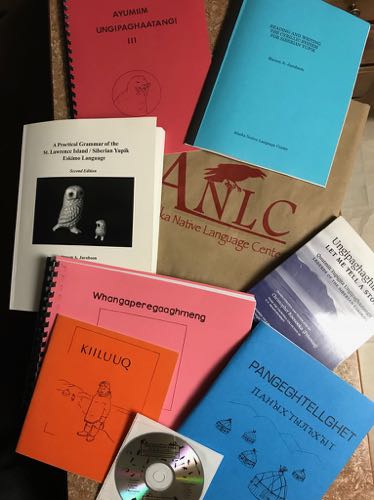Siberian Yupik Language of St. Lawrence Island

As a linguist by trade, one of the first things I do to prepare for any travel is to find the language link, and the (sub) Arctic is no exception. When I learned I would be working and staying in Savoonga, Alaska, a Siberian Yupik community, I just HAD to find out more about their language.
I discovered the Alaskan Native Language Center, which just happens to be on the same University of Alaska Fairbanks campus as my orientation this week, of all the luck! They were super helpful over the phone and via email in the weeks before my orientation, guiding my choices for getting started with this very new language for me. (I highly recommend contacting them for any Alaskan Native Language questions) When I walked in the door today, they knew precisely who I was and had my books all bagged and ready!
Needless to say, after about 2 hours of getting lost in the books, I've got some fun facts to share with you about the Siberian Yupik language. Even if languages aren't your "thing", I think you'll find these pretty interesting:
The Siberian Yupik Eskimo-Aleut language is spoken on St. Lawrence Island in the Bering Sea, and on the tip of Chukotka in Russia. (called Chaplinski there)
Siberian Yupik is the only indigenous language spoken in both Asia and America.
It is one of four Yupik languages, including Naukan, Central Yupik, and Sugpiaq.
The number of speakers is estimated to be around 1,000, far fewer than Central Yupik.
Yupik writing uses the standard Latin alphabet, but not all of the letters are used, and they don't all sound the same as we are accustomed to. In Chukotka, the words are written using the Cyrillic alphabet.
It's the only Eskimo-Aleut language is influenced by and has anywhere between 300-1000 loan words from, another indigenous language, Chukchi.
If you're anxious to see what it looks like, here are some common phrases to get you started:
How are you? natesiin?
good-bye (I'll see you) esghaghlleqamken
thank you igamsiqanaghhalek
welcome quyanaghhalek tagilusi (thank you all for coming)
So you see, the fact that there are so few speakers, concentrated in such a specific location, right where I will be teamed with Alexis and her team, is such a bonus gift for my linguistic interests. This is why pre-expedition research is so valuable.
What do you think?
If you were learning a new language, what would you want to learn to say first? How do you think understanding language helps with understanding place?
*Information from "Let Me Tell a Story" (Koonooka) and "A Practical Grammar of the St. Lawrence Island/ Siberian Yupik Eskimo language."


Comments